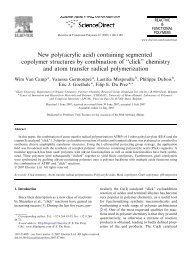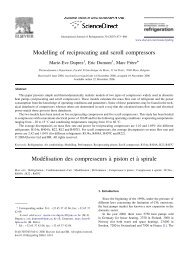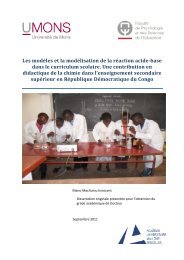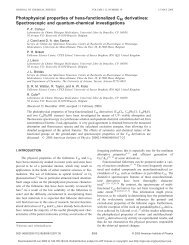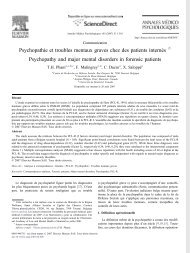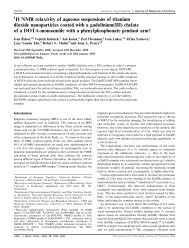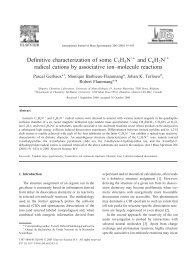Morphology and rheology of poly(methyl methacrylate)-block-poly ...
Morphology and rheology of poly(methyl methacrylate)-block-poly ...
Morphology and rheology of poly(methyl methacrylate)-block-poly ...
- No tags were found...
Create successful ePaper yourself
Turn your PDF publications into a flip-book with our unique Google optimized e-Paper software.
<strong>Morphology</strong> <strong>and</strong> <strong>rheology</strong> <strong>of</strong> <strong>poly</strong>(<strong>methyl</strong> <strong>methacrylate</strong>) ... 1251<strong>and</strong> mechanical properties <strong>of</strong> PMMA-<strong>block</strong>-PIOA-<strong>block</strong>-PMMA tri<strong>block</strong> co<strong>poly</strong>mers (MIM) 5) . The phase morphology<strong>and</strong> the rheological properties <strong>of</strong> these MIM tri<strong>block</strong>co<strong>poly</strong>mers have been analyzed further <strong>and</strong> are thetopic <strong>of</strong> this paper.Experimental partMaterialsMIM tri<strong>block</strong> <strong>and</strong> MI di<strong>block</strong> co<strong>poly</strong>mers were synthesizedby sequential anionic <strong>poly</strong>merization <strong>of</strong> MMA, tert-butylacrylate (tBA) (<strong>and</strong> MMA, in case <strong>of</strong> tri<strong>block</strong>s) respectively,followed by the acid-catalyzed transalcoholysis <strong>of</strong> the tertbutylester groups by isooctyl alcohol. The detailed synthesiswas reported elsewhere 2, 5) . The molecular characteristics <strong>of</strong>the MIM tri<strong>block</strong>s <strong>and</strong> the MI di<strong>block</strong> are listed in Tab. 1. Acommercial grade <strong>poly</strong>styrene-<strong>block</strong>-<strong>poly</strong>isoprene(PIP)-<strong>block</strong>-<strong>poly</strong>styrene tri<strong>block</strong> co<strong>poly</strong>mer, SIPS (Kraton D1107from Shell Development Company, 15l18 wt.-% uncoupleddi<strong>block</strong>), was used for the sake <strong>of</strong> comparison. Theannounced molecular weight (MW) was 10000–120000–10000, with a <strong>poly</strong>styrene content <strong>of</strong> 15 wt.-%.was recorded in the so-called “s<strong>of</strong>t tapping mode” 6) in orderto avoid deformation <strong>and</strong> indentation <strong>of</strong> the <strong>poly</strong>mer surfaceby the tip. All the images were recorded with the maximumavailable number <strong>of</strong> pixels (512) in each direction. Forimage analysis, the Nanoscope image processing s<strong>of</strong>twarewas used. The images were usually reported as captured,repeated scans assessing the reproducibility <strong>of</strong> the observedstructures.Rheological measurementsThe RSI ARES rheometer from Rheometrics equipped witha force balance transducer was used, either in the cone-platemode: (plate: 25 mm diameter, cone: 48 angle, gap: 56 lmbetween the cone tip <strong>and</strong> the plate; for samples 1 <strong>and</strong> 7) or inthe parallel plate mode (25 mm diameter, for all the othersamples). The temperature control was better than 18C. Theapplied strain was always kept within the linear viscoelasticregime, so that the phase morphology did not change undershearing. The frequency range was between0.1 Hzl16.7 Hz. A Polymer Laboratory DMTA (parallelplate with 7 mm diameter) was used to conduct temperaturesweep experiments at 1 Hz (ramp mode, heating rate <strong>of</strong> 28C/min).Sample preparationThin MIM films were cast on mica from dilute solution inTHF (2 mg/ml) <strong>and</strong> sheltered from dust throughout. THFwas let to evaporate very slowly for a few days. The filmswere annealed at 1408C under high vacuum for 24 h beforeAFM observation. The film thickness was ca. 500 nm.Longer annealing times <strong>and</strong> longer thickness did not changethe microphase morphology. Some topological defects werehowever observed for 1–2 mm thick samples. Films suitedto rheological testing, were prepared by casting a co<strong>poly</strong>mersolution (8 wt.-%; 160 ml) in a 100 mm diameter <strong>poly</strong>ethylenedish. The solvent was evaporated over 4 days at roomtemperature. Ca. 1.5 mm films were dried to constant weightin a vacuum oven at 808C for ca. 1 day. The reason formilder conditions compared to the preparation <strong>of</strong> films forAFM observation must be found in the possible dehydrationat 1408C <strong>of</strong> the residual carboxylic acids left by the transalcoholysisreaction, which might affect the rheological data incontrast to the already set up phase morphology. Accordingly,<strong>rheology</strong> will not be discussed in direct relation to themicrophase morphology observed by AFM. The specimenswere colorless, transparent <strong>and</strong> elastomeric with a smoothsurface.AFM observationAll the AFM images were recorded with a Nanoscope IIIamicroscope from Digital Instruments Inc. operated in theTapping Mode (at 258C, in air). Micr<strong>of</strong>abricated cantileverswere used with a spring constant <strong>of</strong> 30 N N m –1 . The instrumentis equipped with the Extender TM Electronics Module,such that height <strong>and</strong> phase cartographies can be simultaneouslyrecorded. Several areas <strong>of</strong> the same sample wereobserved, with scanning time <strong>of</strong> ca. 5 min. The phase imageResults <strong>and</strong> discussionPhase morphologyThe very low electronic contrast between the constitutive<strong>block</strong>s <strong>of</strong> <strong>poly</strong> alkyl(meth)acrylate-containing tri<strong>block</strong>s isquite a problem for the observation <strong>of</strong> nanophase-separatedmorphology by transmission electron microscopy(TEM) <strong>and</strong> small angle X-ray scattering (SAXS). Onlyindirect techniques, such as NMR 7) <strong>and</strong> DMTA 5) , havebeen used for this purpose. However, atomic force microscopy(AFM) with phase detection imaging has provedvery recently to be very appropriate to the direct observation<strong>of</strong> phase separation in fully acrylic <strong>block</strong> co<strong>poly</strong>mers8) . In this work, tapping-mode atomic force microscopy(TMAFM) with phase detection imaging (PDI) hasbeen used, this technique having proven high efficiencyfor the analysis <strong>of</strong> the phase morphology <strong>of</strong> <strong>poly</strong>styrene<strong>block</strong>-<strong>poly</strong>isoprene-<strong>block</strong>-<strong>poly</strong>styreneco<strong>poly</strong>mers 9) .Fig. 1 shows typical AFM images for the MIM tri<strong>block</strong>containing 6.5 wt% PMMA (sample 1, Tab. 1). Theheight image (Fig. 1a) is very uniform, thus indicatingthat the sample surface is very smooth, in line with ca.1.4 nm root mean square roughness for a 161 lm 2 area.This preliminary observation is a guarantee that any contrastobserved in the PDI image will not originate fromdifferences in the surface topography. The phase image(Fig. 1b) clearly shows a two-phase morphology for thesample 1, that consists <strong>of</strong> bright spheres r<strong>and</strong>omly distributedin a dark matrix. Recent models proposed 10) toaccount for the phase contrast in TMAFM indicate that in“s<strong>of</strong>t tapping” operation, the phase shift is directly related



